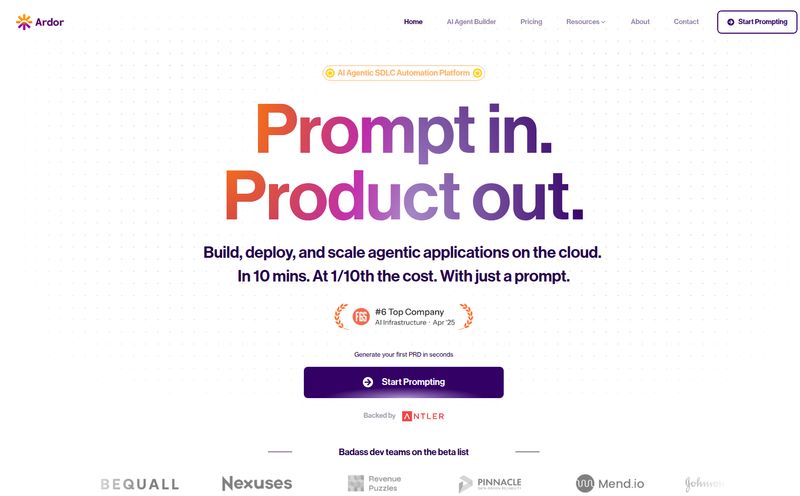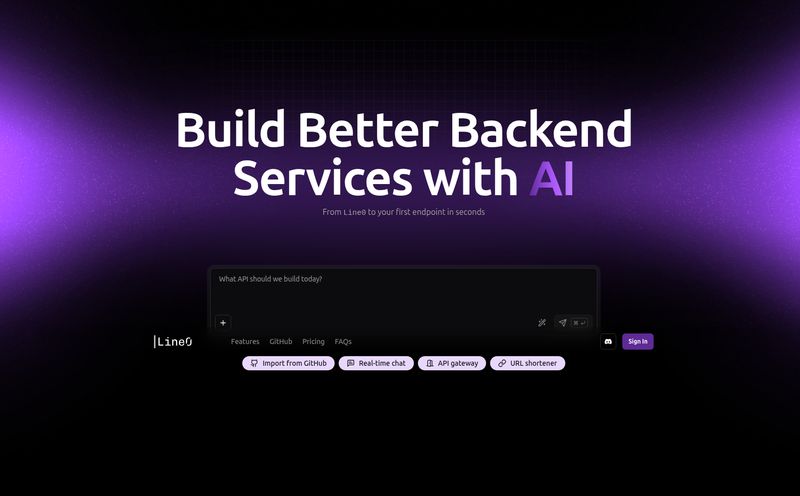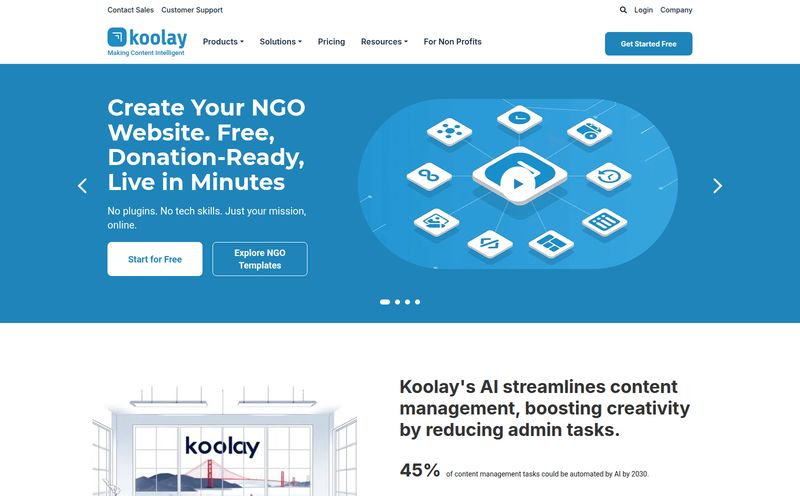As app developers, we’ve all been there. You get a brilliant idea for a feature—something interactive, something that uses the camera, something that feels like the future. Maybe it’s a fitness app that counts reps perfectly, a yoga guide that corrects form, or a physical therapy tool that tracks recovery. And then reality hits. The sheer complexity of building real-time motion tracking from the ground up… it’s a beast. You’re looking at months of R&D, wrestling with complex computer vision libraries, and a budget that makes your CFO break out in a cold sweat.
It’s the kind of roadblock that kills amazing ideas before they even get to the first line of code. I’ve seen it happen. I’ve lived it on a project back in 2019 that we eventually had to shelve. So when a tool like PoseTracker comes along, claiming to do all the heavy lifting for you, my professional skepticism kicks in. But so does my curiosity.
They say they offer industry-leading human pose estimation powered by TensorFlow, all wrapped up in an easy-to-use API. Built by developers, for developers. That last part always gets my attention. So, is it just marketing fluff, or is this the shortcut we’ve been waiting for? I decided to take a closer look.
So, What Exactly is PoseTracker?
At its heart, PoseTracker is a specialized API designed to analyze human movement in real-time. Think of it like a translator. Your app's camera feeds it a video stream of a person, and PoseTracker translates that visual data into a structured, usable format—a digital skeleton, if you will. It identifies key body joints (shoulders, elbows, knees, etc.) and tracks their position and movement from frame to frame.
This isn't some clunky, server-side process that introduces lag. It’s designed for on-edge processing, meaning the magic happens right on the user's device, whether that's an iPhone, an Android, or a web browser. This is critical for creating that smooth, instantaneous feedback that users expect. It’s all built on the back of Google's TensorFlow, which is a name that carries some serious weight in the AI and machine learning world. It's not some fly-by-night operation; they're building on a solid foundation.
The Core Features That Actually Matter
An API can have a million endpoints, but only a few truly define its value. For PoseTracker, the power isn't just in plotting dots on a person; it's what you can do with those dots.
Real-Time Pose Estimation and Motion Tracking
This is the bread and butter. The ability to map a person's body in real time is the core of the whole thing. From what I've seen, the tracking is smooth and responsive. This is the feature that lets you build a rep counter for squats, push-ups, or any other exercise. The user does the movement, and your app, powered by PoseTracker, can see and count it. Simple. Powerful.
Angle Calculations & Motion Analysis
Here’s where it gets really interesting for more sophisticated apps. PoseTracker doesn’t just see the joints; it understands the relationships between them. It can calculate angles—like the bend in an elbow during a bicep curl or the angle of your back during a deadlift. This opens the door for providing genuine, actionable feedback. Your app can go from saying “You did 10 reps” to “You did 10 reps, but on the last 3, your knee angle was a bit off. Try to keep it at 90 degrees.” That’s a game-changer for user experience.
Built-In Tools: Flexibility and Comparison
They also offer some pre-built solutions that are pretty slick. A Flexibility Analysis Tool can measure range of motion, perfect for physical therapy or advanced stretching apps. And the Pose Comparison System allows a user's pose to be compared against a target pose. This is fantastic for any kind of instructional app, from martial arts to dance, where perfect form is everything.
How Painful is the Integration?
This is always the million-dollar question. A powerful tool is useless if it takes a senior engineer two months to integrate. PoseTracker’s big claim is implementation with just “a few lines of code.” And honestly, from looking at their documentation, they're not far off. Because it's an API designed for multi-platform support (iOS, Android, Web), you're not wrestling with native libraries for each system. You make the call, you get the data back. It feels less like a major construction project and more like plugging in a new appliance.
It’s like building a car. You could spend a year trying to design and build an engine from raw metal, or you could buy a high-performance crate engine and just drop it in. PoseTracker is that crate engine for motion analysis. It lets you focus on building the rest of the car—the user interface, the experience, the brand—instead of getting bogged down in the complex mechanics under the hood.
Visit PoseTracker
Let's Talk Money: The Pricing Breakdown
Ah, pricing. The part of the review everyone scrolls down to first. I have to say, I appreciate the transparency here. There’s no “contact us for a demo just to see the price” nonsense for their main tiers. It’s laid out pretty clearly.
| Plan | Cost | Key Features | Best For |
|---|---|---|---|
| Freemium | €0 Forever free | 500 API calls/month, limited pose data, fitness rep counter, non-commercial use only. | Students, hobbyists, or just testing and experimentation. |
| Developer | €50 / month | 5,000 API calls/month, full pose data access, angle calculations, commercial use. | Professional develoeprs, startups, and small to medium-sized apps. |
| Enterprise | Custom Pricing | Custom API limits, all developer features, custom tool development, dedicated support. | Large-scale applications and established companies with specific needs. |
The Freemium plan is genuinely useful for a proof-of-concept. 500 API calls is enough to build a prototype and see if it works for your use case. The big catch is the non-commercial use clause, which is fair. The Developer plan at €50/month feels like the sweet spot. It unlocks the real power and gives you enough API calls to handle a decent user base for a new app. The jump to Enterprise is for when you've hit the big time and need custom solutions and support, which is a pretty standard model.
The Good and The Not-So-Good
No tool is perfect, right? After digging in, here’s my honest take. The big advantages are obvious. The ease of integration is a massive win, saving countless hours and headaches. The multi-platform support is also huge in today's fragmented device market. Having real-time, on-device analysis and a developer-centric API makes it incredibly appealing.
On the flip side, the limitations are mostly tied to the free plan. The cap on pose estimation data means you can't build a super-complex analysis tool without paying up. That's not really a con, just a business model. You get what you pay for. The only other potential drawback is that the Enterprise plan is 'custom pricing', which can sometimes be a lengthy negotiation. But for companies at that scale, that's par for the course.
So, Who Is This For?
PoseTracker isn't for every app. But if you're in the health, wellness, fitness, or sports tech space, you should be paying very close attention. This is for the indie dev with a brilliant idea for a personal training app. It’s for the startup that wants to create a remote physical therapy platform. It’s for digital agencies that want to offer cutting-edge features to their clients without building an in-house AI team. If your app can be improved by understanding human movement, this tool is for you.
Frequently Asked Questions
- 1. What is human pose estimation in simple terms?
- It's a computer vision technique that detects and tracks the key joints of a person in an image or video. Essentially, it turns a person into a real-time stick figure, allowing software to understand their posture and movement.
- 2. Is PoseTracker difficult to set up in my app?
- No, that's one of its main selling points. It's an API, so it's designed for easy integration. Their website says it only takes a few lines of code, and for a basic implementation, that seems accurate. You won't need a PhD in machine learning.
- 3. What platforms does PoseTracker support?
- It supports major platforms including iOS, Android, and Web. They also mention support for low-code platforms, which makes it quite versatile.
- 4. Can I really use it for free?
- Yes, the Freemium plan is €0 and lets you make up to 500 API calls per month. It's perfect for testing and developing a prototype, but it is restricted to non-commercial use only.
- 5. What kind of apps can I build with this?
- The possibilities are pretty broad! Think fitness apps that count reps, yoga or pilates guides that correct form, physical therapy apps that monitor exercises, interactive games that use body movement, or even ergonomic tools that check posture.
- 6. Is it better than building my own solution with something like MediaPipe?
- It depends on your resources. Building your own solution gives you ultimate control but requires significant expertise and time. PoseTracker is a pre-built, managed solution that massively speeds up development time, especially for teams without a dedicated computer vision expert.
Final Thoughts: Is PoseTracker a Go or a No-Go?
Look, the app world is more crowded than ever. Standing out requires more than just a pretty UI. It requires creating genuinely innovative and helpful user experiences. Tools like PoseTracker are what I call “feature accelerators.” They provide a massive technological leap forward, packaged in a way that’s accessible to developers who aren't AI gurus.
For me, it’s a definite go. The pricing is fair, the technology is solid, and the potential it offers to the right kind of app is immense. It turns a feature that was once prohibitively expensive and complex into something a small team or even a solo developer can realistically implement. And in this industry, that’s how you get ahead. That's how you build something truly special.



